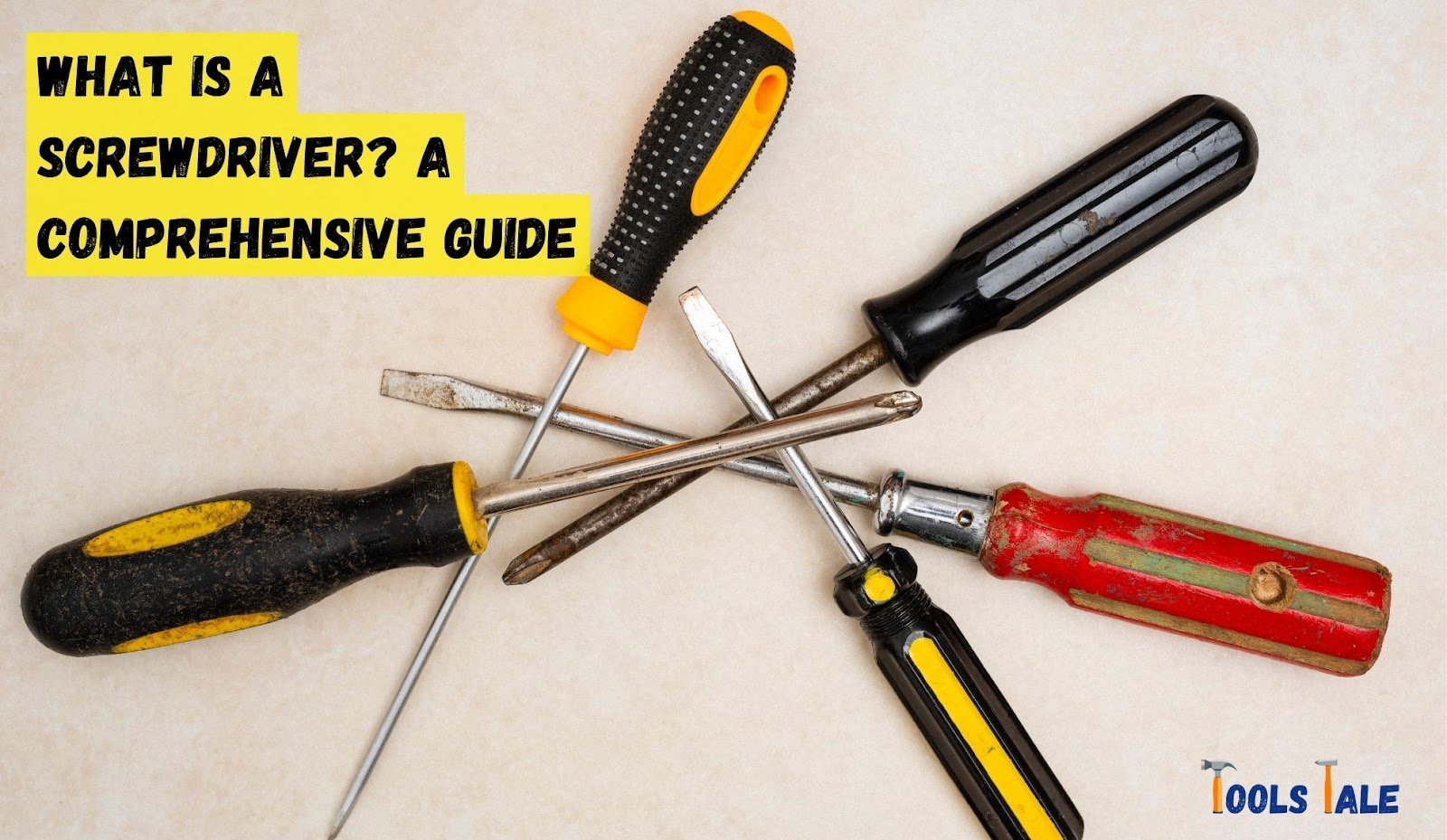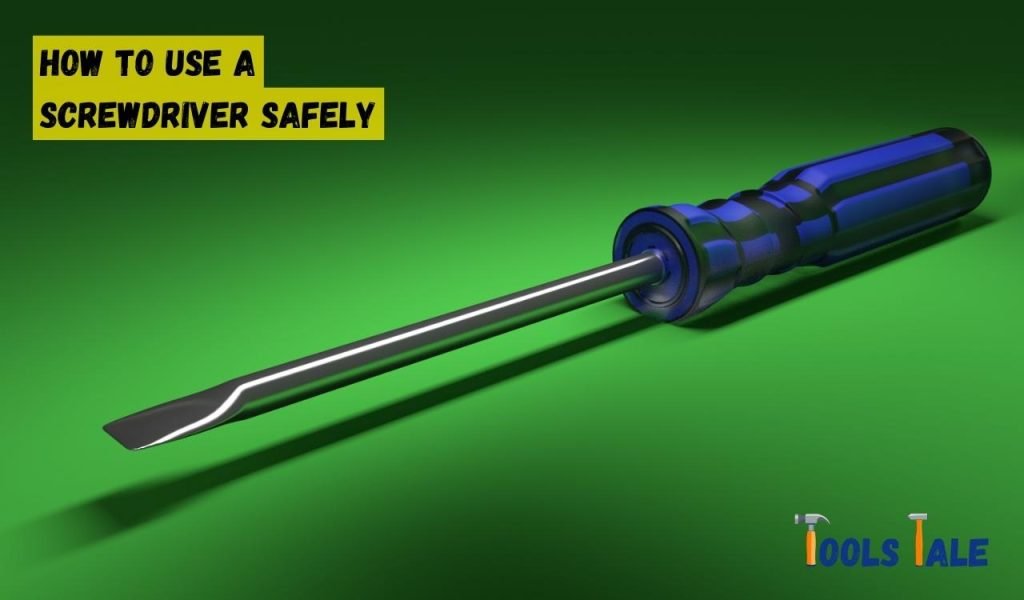Physical Address
304 North Cardinal St.
Dorchester Center, MA 02124
Physical Address
304 North Cardinal St.
Dorchester Center, MA 02124

What is a screwdriver? A simple tool with extraordinary power. Whether you’re a DIY enthusiast or a seasoned professional, this little wonder holds the key to countless projects. From assembling furniture to fixing gadgets, its magic lies in turning screws effortlessly.
So, if you’re curious about unraveling the mysteries of this versatile companion, hop on board! In this guide, we’ll uncover the ins and outs of screwdrivers, explore different types, and reveal expert tips for safe and efficient usage. Get ready to wield the ultimate tool in your arsenal and unlock a world of possibilities! Let’s dive in!
Key Summary: What is a Screwdriver?
A screwdriver is a handheld tool used for turning screws. It consists of a handle and a shaft, with various tip types (e.g., flathead, Phillips) to fit different screw heads. Screwdrivers are essential in DIY projects, electronics, and carpentry, making them a versatile and indispensable tool.
A screwdriver is a fundamental hand tool used for driving screws into or removing them from different materials. Its simple yet effective design consists of a handle and a shaft with a specialized tip, which matches the shape of screw heads. By applying rotational force to the handle, the screwdriver transfers this motion to the screw, either securing it in place or loosening it as needed.
This versatile tool comes in various types, each suited for specific screw head shapes. The flathead screwdriver is recognized by its straight, flat tip, perfect for slotted screws. On the other hand, the Phillips screwdriver, with its cross-shaped tip, excels at turning Phillips screws. Other common types include Torx, Robertson, hex, and precision screwdrivers, each with its unique applications.
Screwdrivers have become an integral part of everyday tasks, from assembling furniture and fixing electronics to more complex DIY projects. Their straightforward design and wide range of variations make them indispensable for both professionals and DIY enthusiasts alike.

Screwdrivers are available in a diverse range of types, each tailored to handle specific screw head shapes and tasks. Understanding the various types can significantly enhance your efficiency and effectiveness when working with screws. Here are the most common types of screwdrivers:
The flathead, also known as a slotted screwdriver, features a flat, straight tip, which fits into slotted screw heads. It is one of the most basic and widely used types of screwdrivers. However, it’s essential to choose the correct size to prevent slipping and damaging the screw head.
The Phillips screwdriver is easily recognizable by its cross-shaped tip, designed to fit into Phillips screws. The cruciform recess on the screw head allows for better torque transfer and reduces the likelihood of slipping. It is commonly used in various applications and ideal for screws that require higher torque.
Torx screwdrivers have a star-shaped tip and are commonly found in electronics, automotive, and machinery. The design of the Torx screw head and driver provides a more substantial grip, reducing the risk of stripping and ensuring efficient torque transfer.
The Robertson, or square-tip, screwdriver is popular in construction and woodworking. Its square-shaped tip offers excellent torque, preventing the driver from slipping out of the screw head. This design makes it easier to drive screws in challenging materials.
The hex screwdriver, often referred to as an Allen wrench, is used with hexagonal screw heads. These screws are commonly found in furniture assembly and machinery. Hex screwdrivers come in various sizes, allowing you to tackle a wide range of tasks.
Precision screwdrivers are smaller versions used for delicate tasks, such as repairing electronics, watches, or eyeglasses. They come in various tip shapes, including flathead, Phillips, Torx, and more, catering to intricate and precise work.
Apart from the standard types, there are specialty screwdrivers designed for specific tasks. These may include security screwdrivers for tamper-resistant screws, ratcheting screwdrivers for faster turning, and magnetic screwdrivers to hold screws in place.
Selecting the appropriate screwdriver for a particular job is crucial for achieving the best results and preventing damage. Considering various factors can help you make the right choice and ensure a smooth and efficient screwdriving experience. Here are essential points to keep in mind when choosing the right screwdriver:
Identify the type of screw head you’ll be working with, such as slotted, Phillips, Torx, or square. Each screw head shape requires a specific screwdriver type for optimal engagement and torque transfer. Using the wrong screwdriver may result in damaging the screw head, making it difficult to drive or remove the screw.
Pay close attention to the size of the screw head and choose a screwdriver that matches it precisely. Using a screwdriver with an ill-fitting tip can cause the tool to slip, potentially injuring your hand or damaging the screw head. The correct size ensures a secure fit and allows you to exert the necessary force without issues.
Comfort is crucial when working with screwdrivers, especially during tasks that require significant effort. Choose a screwdriver with an ergonomic handle that feels comfortable and provides a firm grip. Ergonomic handles reduce hand fatigue and enhance control, making your work more efficient and comfortable.
Invest in high-quality screwdrivers made from durable materials. Cheap or low-quality screwdrivers are prone to wear and may lose their precision over time. High-quality tools, while they may cost more initially, will last longer, perform better, and offer a safer working experience.
Consider using screwdrivers with magnetic tips, especially when dealing with small screws or hard-to-reach areas. Magnetic tips securely hold the screws in place, making it easier to start and drive them without dropping or losing them during the process.
For specific tasks or unique screw types, such as tamper-resistant screws, consider investing in specialty screwdrivers. These specialized tools are designed for specific purposes and can make challenging tasks more manageable and efficient.
If you frequently work with a wide variety of screws, having a multi-bit or interchangeable screwdriver can be beneficial. These types of screwdrivers come with various tips that can be easily swapped, providing flexibility and convenience in a single tool.
Think about the specific application or task you’ll be performing. Different projects may require different types of screwdrivers. For example, precision screwdrivers are ideal for delicate electronics, while heavy-duty projects may require larger, sturdier screwdrivers.

Using a screwdriver safely is essential to avoid accidents, injuries, and damage to materials or screws. By following these safety guidelines and best practices, you can ensure a smooth and incident-free screwdriving experience:
Depending on the task at hand, consider wearing appropriate safety gear. Safety goggles can protect your eyes from flying debris or metal shavings, while gloves can provide added grip and shield your hands from sharp edges.
Always use the correct-sized screwdriver for the job. Using a screwdriver with an improperly sized tip can lead to slipping, which may result in injuries or damage to the screw head. Ensure the screwdriver’s tip matches the screw head precisely.
When turning a screw, apply steady and controlled pressure on the handle. Avoid using excessive force, as this can cause the screwdriver to slip or the screw head to strip. Steady pressure allows for better control and reduces the risk of accidents.
Position the screwdriver’s tip firmly into the screw head before turning. Ensure the tip fits snugly into the screw’s slot or recess to prevent slipping. Keeping the screwdriver aligned with the screw head minimizes the chance of damaging the surrounding material.
Understand the direction to tighten and loosen the screws. Turn the screwdriver clockwise to tighten and counter-clockwise to loosen. Applying force in the wrong direction can damage the screw or material.
Before use, inspect the screwdriver for any signs of damage, wear, or bending. Damaged tools should not be used, as they can lead to accidents or result in poor-quality work. Replace worn or damaged screwdrivers promptly.
After use, store your screwdrivers in a clean and organized manner. Proper storage helps maintain their condition and prevents them from becoming a hazard in your workspace.
When driving screws into tough materials, use a two-handed grip on the screwdriver. This provides better control and stability, reducing the risk of the tool slipping during use.
Ensure you have sufficient lighting when working with screws. A well-lit workspace allows for better visibility, reducing the likelihood of mistakes or accidents.
When working with electrical equipment or appliances, ensure they are disconnected from power sources to avoid electric shocks or short circuits.
Keep your fingers and hands away from the screw head and the path of the screwdriver to avoid accidental injuries.

Screwdrivers are indispensable tools that offer a plethora of benefits, making them a must-have in any toolbox. From their versatility to user-friendly design, screwdrivers prove to be essential for various tasks and projects. Here are the key benefits of using screwdrivers:
Screwdrivers are incredibly versatile tools that find applications in numerous fields. From household repairs and carpentry to electronics and automotive work, screwdrivers can handle a wide range of tasks with ease and precision.
One of the significant advantages of screwdrivers is their user-friendly design. With a simple construction of a handle and a shaft with a tip, they are easy to use and require minimal learning curve. This accessibility makes them ideal for both professionals and DIY enthusiasts.
Screwdrivers offer precise control over the torque applied to screws. This control is crucial when dealing with delicate materials or working in confined spaces where accuracy is paramount. The ability to make precise adjustments ensures a clean and reliable finish.
Screwdrivers are among the most affordable hand tools available in the market. They are readily accessible to individuals of all skill levels and budgets. This affordability makes it possible for everyone, from professionals to hobbyists, to have a reliable set of screwdrivers.
Using the right screwdriver for the job can significantly reduce the time and effort required to complete tasks. Their efficient operation and ease of use enable users to work quickly and achieve desired results promptly.
For DIY enthusiasts, screwdrivers are indispensable. From assembling furniture to fixing household items, they empower individuals to tackle various projects without relying on professional help.
Screwdrivers are essential tools for regular maintenance and repairs. Whether it’s tightening loose screws or fixing minor issues, they allow users to address problems promptly and prevent them from escalating.
Screwdrivers are compact and lightweight, making them highly portable. They can be easily carried in tool belts or pockets, making them ideal for on-the-go repairs or projects.
High-quality screwdrivers made from durable materials can withstand frequent use and retain their effectiveness over time. Investing in reliable tools ensures longevity and consistent performance.
Screwdrivers are specifically designed to work with screws and fasteners. Compared to alternative methods like nails or glues, screws provide stronger and more secure connections in various materials.
Beyond their primary function of driving screws, screwdrivers can be employed in various creative ways. They can be used for prying open lids, scraping surfaces, or even as improvised punches.
The slim and elongated design of screwdrivers allows them to reach screws in tight spaces that other tools might struggle to access. This feature enhances their usefulness and effectiveness in diverse environments.
Screwdrivers are indispensable for delicate and precision work, such as repairing delicate electronics, assembling intricate mechanisms, or fine-tuning instruments.
Screwdrivers made from durable materials and designed for long-term use contribute to sustainability efforts by reducing the need for disposable tools.
Using a screwdriver requires care and attention to ensure safe and efficient operation. By avoiding common pitfalls and mistakes, you can prevent accidents, protect your workpieces, and extend the life of your tools. Here are essential things to avoid when using a screwdriver:
Avoid using a screwdriver with an improper tip size or type for a particular screw head. Using the wrong screwdriver can damage the screw head, making it difficult to turn or remove and potentially causing injury.
Resist the temptation to apply excessive force while turning a screw. Too much force can lead to the screwdriver slipping, resulting in injuries or damaging the surrounding material. Apply steady and controlled pressure for better results.
Always wear appropriate safety gear, such as safety goggles and gloves, when working with a screwdriver. Safety goggles protect your eyes from debris, while gloves offer added grip and safeguard your hands from sharp edges.
Avoid over-tightening screws, as it can cause the material to crack or warp, compromising the structural integrity of the object. Tighten the screw until snug, but be mindful not to exert excessive force.
Do not use damaged or worn-out screwdrivers, as they can lead to poor-quality work and potential accidents. Regularly inspect your tools and replace any that show signs of wear or damage.
Properly store your screwdrivers after use. Leaving them lying around or storing them haphazardly can lead to damage or create hazards in your workspace.
Avoid using a screwdriver for purposes other than turning screws. Using it as a chisel or pry bar can damage the tool and pose safety risks.
When working with electrical equipment, always disconnect them from power sources to prevent electric shocks or short circuits.
Be mindful of screws in hidden or tight spaces. Attempting to access and turn these screws without proper visibility or maneuverability can lead to accidents.
While magnetic screwdrivers can be convenient, avoid using them near sensitive electronics. The magnetic field can cause damage to delicate components or interfere with electronic devices.
Use screws that are appropriate in length for the application. Screws that are too long can damage or protrude through the material, while screws that are too short may not provide a secure hold.
Always ensure that the workpiece is securely held in place before driving screws. A loose or unstable workpiece can result in misaligned screws or accidents during screwdriving.
In conclusion, screwdrivers are indispensable tools with a wide range of benefits, offering versatility, user-friendliness, and precise control. By using them safely and avoiding common mistakes, you can enhance your efficiency, protect your work, and ensure a successful and enjoyable screwdriving experience. Keep the right tools on hand, follow safety guidelines, and work with care to make the most of this essential tool in your toolbox.
A screwdriver is a hand tool used for turning screws to fasten or unfasten them. It is commonly used in construction, carpentry, electronics, and various DIY projects.
A screwdriver works by applying torque to the screw head, causing it to rotate. The driver’s tip fits into the screw’s recess, enabling it to drive the screw into or out of a material.
There are various types of screwdrivers, including flat-head (slotted), Phillips, Pozidriv, Torx, Allen (hex), and Robertson (square), each designed for specific screw head shapes.
To choose the right screwdriver, match the tip type and size to the screw head. Ensure a snug fit to prevent slipping and potential damage to the screw head.
No, using a screwdriver as a chisel or pry bar is not recommended. It can damage the tool and pose safety risks. Always use tools for their intended purpose.
To use a screwdriver safely, wear appropriate safety gear, apply steady pressure, use the correct size, and avoid over-tightening. Keep fingers away from the screw head and work carefully.
To remove a stripped screw, press down firmly on the screwdriver while turning, or use a rubber band between the screw head and driver for better grip. Alternatively, use a screw extractor tool.
Store screwdrivers in a clean, organized toolbox or tool rack. Keep them dry to prevent rust. Regularly inspect for wear or damage, and replace damaged tools promptly.
High-quality screwdrivers have durable materials, ergonomic handles, and precision-machined tips for a secure fit. They provide a comfortable grip and offer reliable performance over time.
Yes, some screwdrivers are designed for use with power tools, known as power screwdrivers or electric screwdrivers. They can speed up screwdriving tasks and are useful for repetitive work.